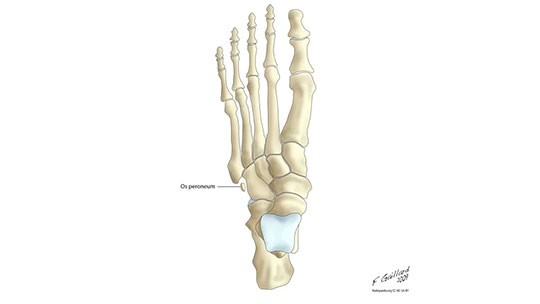OS Peroneum
The Os Peroneum is an extra small piece of cartilage or bone that is located in the peroneus longus tendon (the tendon that is located on the outside of the lower leg and ankle). Two sections start together at the upper portion of the lower leg, travel down the lengh of the lower leg and wrap around the ankle bone. Os Peroneum is very common (up to 26% of feet).
WHAT CAUSES PAINFUL OS PERONEUM SYNDROME?
Painful Os Peroneum Syndrome is caused by a fracture of the Os Peroneum, ruptured tendons around the Os Peroneus, or entrapment of the Os Peroneus or peroneus tendon. Dancers, runners, and athletes are more likely to develop Painful Os Peroneum Syndrome.
HOW DO I KNOW IF I HAVE PAINFUL OS PERONEUM SYNDROME?
WHAT ARE THE SYMPTOMS OF PAINFUL OS PERONEUM SYNDROME?
Many people confuse Painful Os Peroneum Syndrome wtih a tendon tear due to Os Peroneum infrequency. If you notice pain, tenderness, and mild burning in the lateral ankle you may have Painful Os Peroneum Syndrome. Another very common symptom is the feeling of standing on a sharp rock right under the cuboid (near the ankle) bone.
HOW IS PAINFUL OS PERONEUM SYNDROME DIAGNOSED?
MRI’s, Ultrasounds, and X-Rays can detect this syndrome. Your foot specialist may have you do certain heel rises and stress tests to also determine diagnosis.
WHAT CAN I DO FROM HOME FOR PAINFUL OS PERONEUM SYNDROME?
WHAT CAN I DO TO PREVENT PAINFUL OS PERONEUM SYNDROME?
- Avoid shoes that don’t offer good support
- Replace shoes regularly
WHAT TREATMENTS CAN I DO FROM HOME FOR PAINFUL OS PERONEUM SYNDROME?
- Take anti-inflammatory medication
- Wear shoe / arch orthotics
- If you are experiencing severe pain, wearing a short boot can alleviate the pain.
- Find orthotics to match your arch type, for more information go here
WHEN SHOULD I SEE A DOCTOR FOR PAINFUL OS PERONEUM SYNDROME?
Obtain an appointment with a foot specialist immediately after noticing Painful Os Peroneum Syndrome.
WHAT TREATMENTS ARE AVAILABLE FOR PAINFUL OS PERONEUM SYNDROME
Non-Surgical:
Anti-inflammatory medications, orthotics, short boot.
Surgical:
Surgery is required more often than not. However, surgery is usually only offered after a patient has tried alternative treatments for 3 – 6 months. If that doesn’t work surgery can be scheduled to remove the Os Peroneum bone or cartilage. The surgeon has to be extremely careful not to damage the peroneal tendon, and if it is already damaged the surgeon will repair it.

